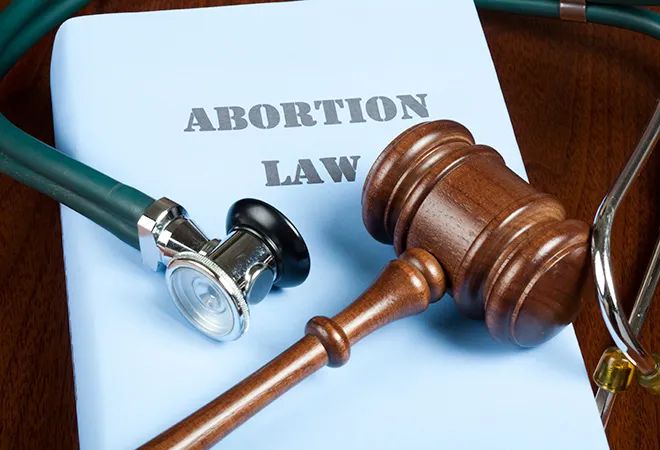Legal Dimensions of abortion: rights, regulations and controversies

Author: Krishna Shroff, student of GLS University
“Many of us were the unplanned children of talented, creative women whose lives had been changed by unplanned and unwanted pregnancies. We witnessed their bitterness, their rage, their disappointment with their lot in life and we were clear that there could be no genuine sexual liberation for women and men without better, safer contraceptives, without the right to a safe, legal abortion.”
― Bell hooks, Feminism Is for Everybody: Passionate Politics
This is a quote from one of my favorite authors. The right to a safe, legal abortion is a right for everyone who identifies as a woman. It is a miracle that women have the power to bring life into this world, it is a superpower I think. To make a human inside the body is the most fascinating and liberating thing as women have been told but it is also liberating to have a choice to not bring life into this world.
The definition of abortion is the deliberate termination of a human pregnancy, most often performed during the first 28 weeks of pregnancy. It is a process of terminating the child due to multiple reasons with the consent of the mother
Earlier in India, abortion was considered illegal and went against all the moral grounds of the people. Societies thought that killing a child is considered a murder and it was evil. People believed that Women had the sole purpose to bring life into the world. To not fulfill the purpose means going against the god. Due to all of these notions, abortion was prohibited in India. Women were killed facing many complications but killing the child was illegal. Section 312 of the Indian penal code explicitly states that “voluntarily causing miscarriages, even when the miscarriage is with the consent of women”, is a criminal offense.
Unwanted pregnancies lead to many harmful health conditions and poor body autonomy. Until 1970s abortion was punishable in India, a woman could face three years of imprisonment and fine. After India got independence, the societies became more progressive and aware of the consequences of unwanted pregnancy.
Some reasons for abortion are as follows:
- Financial circumstances
Many women do not have the monetary grounds to bear the responsibility of a child. They aren’t ready to support the child. Many have terminated their pregnancy because of lack of insurance and minimum working pay.
- Timing
Many feel like they aren’t emotionally and physically ready to go through the pregnancy. They go through an unplanned pregnancy but then the consequences are too much to handle, which can lead to depression and several other mental and physical issues.
- Partner and Family issues
Many women who choose abortion are unmarried. Having no serious commitment from a partner can be a strong ground to terminate a child. There’s also a lot of family pressure which leads to fear, and they get an abortion done because women believe they won’t get support from their family. Abortion can be done when there’s a rape or incest.
- Mental health
Numerous women aren’t mentally sound enough to go through the pregnancy. They do not have the emotional bandwidth to bear the pain and the symptoms of the pregnancy.
Shantilal Shah Committee:
Over time, the mindfulness regarding rights in Indian society gained pace as equivalency and liberty were deeply pressed upon. The concept of rights gradually gained momentum and attained significant importance in Indian society. This shift in perspective paved the way for discussions on legislation related to abortions, which began to take shape in the 1960s with the establishment of the Shantilal Shah Commission by the government.
The commission was formed to decide and regulate the procedure to legalize abortions. The government of India set up the commission to drop the high maternal morbidity and mortality associated with illegal abortions. It was formulated to see the state of the abortions in the country and how laws can be made to regulate abortions.
The crucial recommendations of the Shah Committee have been analyzed below
Prior to the 1960s, abortion in India was prohibited, carrying the potential for severe consequences. Under Section 312 of the Indian Penal Code (IPC), a woman could face imprisonment and/or a fine up to three times. In a pivotal shift during the mid-1960s, the Indian government took a significant step by establishing the Shantilal Shah Committee. Tasked with examining the issue of abortions, the committee, led by Dr. Shantilal Shah, was entrusted to determine the necessity of enacting a law addressing this matter in India
The recommendations of the Shantilal Shah Committee culminated in the introduction of a medical termination bill in both the Lok Sabha and Rajya Sabha. This legislative proposal, reflective of the committee’s findings, successfully passed through Parliament in August 1971.
The Medical Termination of Pregnancy Act 1971:
The Medical Termination of Pregnancy (MTP) Act, 1971, became effective on April 1, 1972, and was applicable throughout India, excluding the state of Jammu and Kashmir. It was established for the safety of women’s health and for better and safer abortions. It not only helped the medical practitioners but also decriminalized performing abortion and provided a safer and judgment free space for termination of the baby.
Shantilal Shah Commission recommended MTP Act 1971 on moral, societal and philanthropic grounds to advocate for better abortions and promote body autonomy. As the society progresses and develops, the perspectives of the people change. It was the need of the hour to make some amends into the MTP Act, 1971 to regulate it more with the current context seeing the complications and developments. So the Medical Termination of pregnancy Act 2021 was legislated to give women with comprehensive abortion care.
Salient features of this bill are:
The legislation allows for abortion to be permissible up to 20 weeks based on the professional judgment of a single medical practitioner.
To terminate abortion between 20 and 24 weeks, the opinion of two doctors is needed. This extension of the abortion period up to 24 weeks is given for special orders of women similar as rape/ incest victims, else- baled women, and minors
For abortions beyond 24 weeks, a state- position Medical Board will decide if it can be permitted, in case of substantial fetal abnormalities
The Bill specifies that only doctors specialized in Gynecology/Obstetrics are authorized to conduct abortions. Additionally, it emphasizes the confidentiality of a woman’s identity and pregnancy termination details, barring disclosure except to individuals authorized by law.
In cases where pregnancies are asked to terminate because of a rape, where the abortion period exceeds 24 weeks, the only manner would be through a writ petition.
Landmark case:
A recent landmark judgment of X vs. Principal Secretary changed the course of abortion and paved a better road. The woman approached Delhi High Court seeking authorization to terminate the 24 week pregnancy. She wanted to terminate it because she was unmarried and was not ready for a child and to face a judgmental society. The court declined the request so she approached the Supreme Court requesting for termination as this unwanted pregnancy can ruin her mental being.The social stigma and harassment of being a single mother will be too much for her to handle. In an unanimous opinion, the court held that the unmarried women will be allowed for the termination of a child under Rule 3B. Unwanted pregnancy can be painfully hard on the mothers and especially if she has to do it alone, it can greatly affect her mental and physical well being.
In the Kerala high court, a plea was declined of a 12 year old girl to terminate her pregnancy of 34 weeks; she was in an incestual relationship with her minor brother. The parents requested the court to think about the mental and physical condition of the girl but the court said 34 weeks is the full period where the fetus is developed and is ready to come into this world so terminating the child now will go against the laws and will have health consequences on the mother too.
Conclusion:
In conclusion, the legal dimensions of abortion encompass a complex web of rights, regulations, and controversies that reflect the broader societal and ethical debates surrounding reproductive autonomy. The recognition of a woman’s right to choose and control her own body has been a significant milestone in many legal frameworks, affirming the principles of individual autonomy and bodily integrity. However, this right exists in a delicate balance with the state’s interest in protecting potential life and regulating medical practices.
Regulations on abortion vary widely across jurisdictions, leading to diverse legal landscapes that shape access to reproductive healthcare services. While some countries have embraced liberal abortion laws, others maintain restrictive measures, placing significant limitations on when and under what circumstances abortions can be performed. These differences underscore the persistent global disparities in women’s reproductive rights and access to safe and legal abortion.
Controversies surrounding abortion often emerge from the intersection of deeply rooted cultural, religious, and moral beliefs. Debates over the beginning of human life, the rights of the unborn, and the societal role in shaping reproductive choices continue to fuel discussions and legal challenges. Striking a balance between protecting the rights of pregnant individuals and addressing the concerns of those who oppose abortion presents an ongoing challenge for lawmakers and societies alike.
Sources:


